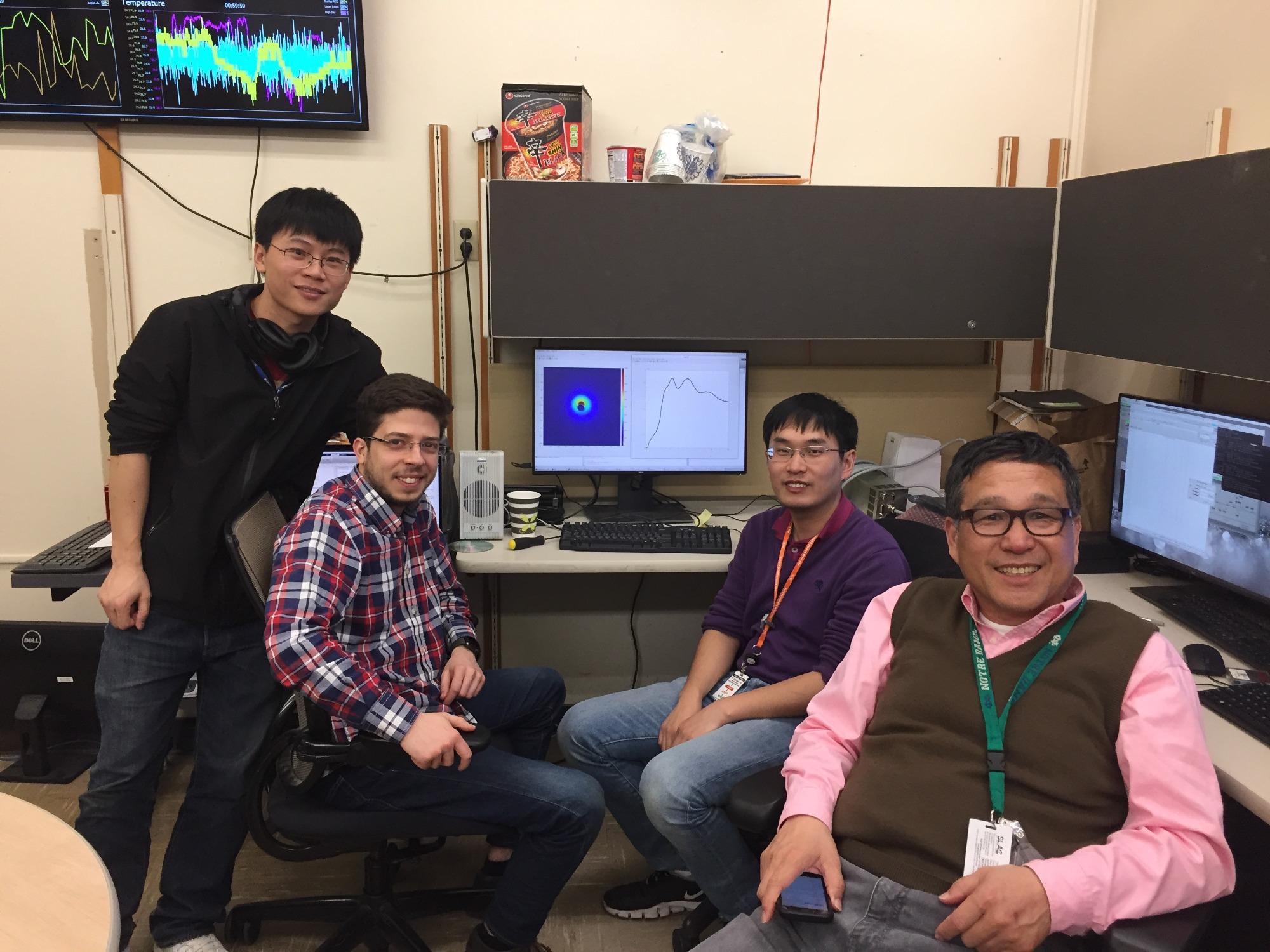Reviewed by Alex SmithAug 26 2021
Water is the most abundant resource and least understood element in nature. It displays several peculiar behaviors that are challenging to explain. Most liquids turn denser as they get colder, but water is most dense at a temperature of 39 °F, which is just above the freezing point.
 For these experiments, the research team (left to right: Xiaozhe Shen, Pedro Nunes, Jie Yang, and Xijie Wang) used SLAC’s MeV-UED, a high-speed “electron camera” that uses a powerful beam of electrons to detect subtle molecular movements in samples. Image Credit: Dawn Harmer/SLAC National Accelerator Laboratory.
For these experiments, the research team (left to right: Xiaozhe Shen, Pedro Nunes, Jie Yang, and Xijie Wang) used SLAC’s MeV-UED, a high-speed “electron camera” that uses a powerful beam of electrons to detect subtle molecular movements in samples. Image Credit: Dawn Harmer/SLAC National Accelerator Laboratory.
This is why ice floats on the top of a drinking glass and the lakes freeze from the surface down, enabling the survival of marine life in cold winters. Water also possesses an unusually high surface tension, allowing the insects to walk on its surface. It also has a higher capacity to store heat, which maintains the ocean temperature in a stable state.
Now, a team of researchers from the Department of Energy’s SLAC National Accelerator Laboratory, Stanford University, and Stockholm University in Sweden, have undertaken the first direct observation of the method by which hydrogen atoms in water molecules tug and push adjacent water molecules, during excitation caused by laser light.
The study showed the effects that highlight important factors of the microscopic origin of the strange characters of water. It could also lead to higher learning of how water helps proteins function in living organisms.
Although this so-called nuclear quantum effect has been hypothesized to be at the heart of many of water’s strange properties, this experiment marks the first time it was ever observed directly. The question is if this quantum effect could be the missing link in theoretical models describing the anomalous properties of water.
Anders Nilsson, Study Collaborator and Professor of Chemical Physics, Stockholm University
Every water molecule comprises an oxygen atom and two hydrogen atoms. It also holds a web of hydrogen bonds between positively charged hydrogen atoms in one molecule and negatively charged oxygen atoms in neighboring molecules, which binds them together.
This complicated network influences the inexplicable properties of water. However, until recently, researchers were unable to directly view the method by which water molecules interact with their neighbors.
The low mass of the hydrogen atoms accentuates their quantum wave-like behavior. This study is the first to directly demonstrate that the response of the hydrogen bond network to an impulse of energy depends critically on the quantum mechanical nature of how the hydrogen atoms are spaced out, which has long been suggested to be responsible for the unique attributes of water and its hydrogen bond network.
Kelly Gaffney, Collaborator and Scientist, Stanford PULSE Institute, SLAC National Accelerator Laboratory
Love thy Neighbor
Until recently, it has been very challenging to make this observation as the motions of the hydrogen bonds are very small and quick. The current experiment resolved that issue by using SLAC’s MeV-UED, a high-speed “electron camera” capable of detecting subtle molecular movements by scattering a powerful beam of electrons off samples.
The researchers developed 100-nm-thick jets of liquid water, which is about 1000 times thinner than the width of human hair. They then set the water molecules vibrating with infrared laser light. The molecules were then set to blast with short pulses of high-energy electrons from MeV-UED.
This delivered high-resolution snapshots of the shifting atomic structure of the molecule. They strung together into a stop-motion movie of how the network of water molecules responded to the light.
The snapshots, which focused on groups of three water molecules, showed that when an excited molecule begins to vibrate, its hydrogen atoms tug oxygen atoms from neighboring water molecules. Then, they pushed them away with their newfound strength, which expands the space between the molecules.
“For a long time, researchers have been trying to understand the hydrogen bond network using spectroscopy techniques. The beauty of this experiment is that for the first time we were able to directly observe how these molecules move,” stated Jie Yang, a former SLAC scientist and now an associate professor at Tsinghua University in China, who led the study.
A Window on Water
The researchers expect to use this technique to obtain more information about the quantum nature of hydrogen bonds and the role they contribute to the strange characters of water. They also look forward to understanding more about the important role of these properties in many biological and chemical processes.
This has really opened a new window to study water. Now that we can finally see the hydrogen bonds moving, we’d like to connect those movements with the broader picture, which could shed light on how water led to the origin and survival of life on Earth and inform the development of renewable energy methods.
Xijie Wang, Study Collaborator and Distinguished Staff Scientist, SLAC National Accelerator Laboratory
MeV-UED is an instrument of the Linac Coherent Light Source (LCLS) user facility, operated by SLAC on behalf of the DOE Office of Science, which financially supported the research.
Journal Reference:
Yang, J., et al. (2021) Direct observation of ultrafast hydrogen bond strengthening in liquid water. Nature. doi.org/10.1038/s41586-021-03793-9.